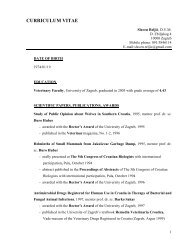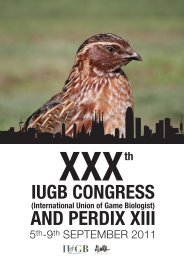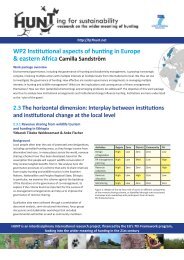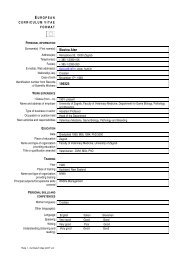Hunting for Sustainability in Africa
Hunting for Sustainability in Africa
Hunting for Sustainability in Africa
Create successful ePaper yourself
Turn your PDF publications into a flip-book with our unique Google optimized e-Paper software.
<strong>Hunt<strong>in</strong>g</strong> <strong>for</strong> <strong>Susta<strong>in</strong>ability</strong> <strong>in</strong> <strong>Africa</strong> – Ethiopia Research Brief<strong>in</strong>gs<br />
Trophy hunt<strong>in</strong>g and conservation of mounta<strong>in</strong> nyala<br />
Background<br />
• The mounta<strong>in</strong> nyala (Tragelaphus buxtoni) is an endangered antelope that is endemic to Ethiopia with<br />
an estimated population size around 4000. It is trophy hunted <strong>for</strong> its large spiralled horns<br />
• Trophy hunt<strong>in</strong>g has the potential to support conservation of trophy species and wider biodiversity<br />
• However, mak<strong>in</strong>g decisions to benefit species, habitats and people is challeng<strong>in</strong>g because priorities<br />
differ between <strong>in</strong>terest groups, but also because of a lack of <strong>in</strong><strong>for</strong>mation on key components of the<br />
system, such as mounta<strong>in</strong> nyala population sizes<br />
Method<br />
• We used a new modell<strong>in</strong>g method that facilitates decision mak<strong>in</strong>g when there is limited <strong>in</strong><strong>for</strong>mation<br />
and diverg<strong>in</strong>g objectives. This approach is widely used <strong>in</strong> fisheries and explicitly lays out the trade-offs<br />
<strong>in</strong>volved <strong>in</strong> different policies, so that decision-makers can act with a clearer understand<strong>in</strong>g of<br />
uncerta<strong>in</strong>ties and consequences associated to these policies<br />
Key f<strong>in</strong>d<strong>in</strong>gs<br />
• The quality and quantity of <strong>in</strong><strong>for</strong>mation available to decisionmakers<br />
determ<strong>in</strong>es their ability to make <strong>in</strong><strong>for</strong>med decisions.<br />
Our study on mounta<strong>in</strong> nyala showed that the 10 years of<br />
monitor<strong>in</strong>g data currently available are sufficient to make<br />
<strong>in</strong><strong>for</strong>med decisions<br />
Observation<br />
process<br />
Perceived<br />
Government<br />
model<br />
Quota<br />
• However, robust decision-mak<strong>in</strong>g is currently hampered by<br />
large uncerta<strong>in</strong>ties <strong>in</strong> the precision of population monitor<strong>in</strong>g.<br />
The effects of poach<strong>in</strong>g and habitat loss (from human<br />
encroachment) on the nyala population are unknown<br />
Monitor<strong>in</strong>g<br />
Population<br />
model<br />
Poach<strong>in</strong>g<br />
Local<br />
people<br />
Conclusions<br />
• The proposed framework is transferable and appropriate <strong>for</strong> many small-scale terrestrial systems <strong>in</strong><br />
develop<strong>in</strong>g countries. It is very flexible and easily <strong>in</strong>tegrated <strong>in</strong>to adaptive management<br />
• Our approach can use qualitative and quantitative <strong>in</strong><strong>for</strong>mation (e.g. social, economic and ecological<br />
data) and the full extent of past data (time series)<br />
• Quota sett<strong>in</strong>g <strong>for</strong> mounta<strong>in</strong> nyala should ideally take population trends and past harvest quota <strong>in</strong>to<br />
account . This balances the trade-offs between conservation of mounta<strong>in</strong> nyala, economic profit and<br />
stability better than the commonly used rule of tak<strong>in</strong>g a proportion of the population. Under current<br />
uncerta<strong>in</strong>ties, an adaptive, iterative approach which uses estimates of poach<strong>in</strong>g and habitat loss,<br />
population monitor<strong>in</strong>g and past quotas will most likely lead to higher harvests than the current<br />
management. However, an <strong>in</strong>crease <strong>in</strong> quota will only be susta<strong>in</strong>able if also habitat loss and poach<strong>in</strong>g<br />
are kept at a susta<strong>in</strong>able level<br />
Contact: Nils Bunnefeld n.bunnefeld06@imperial.ac.uk May 2012<br />
4/5







